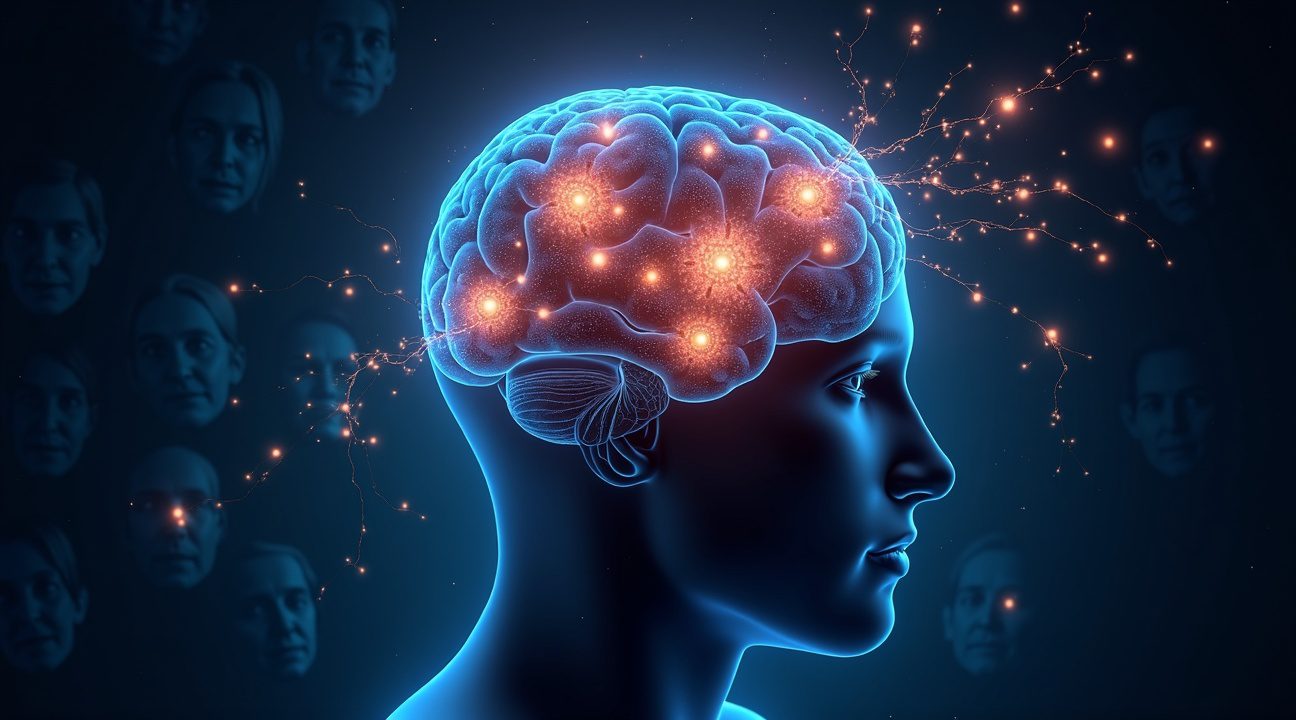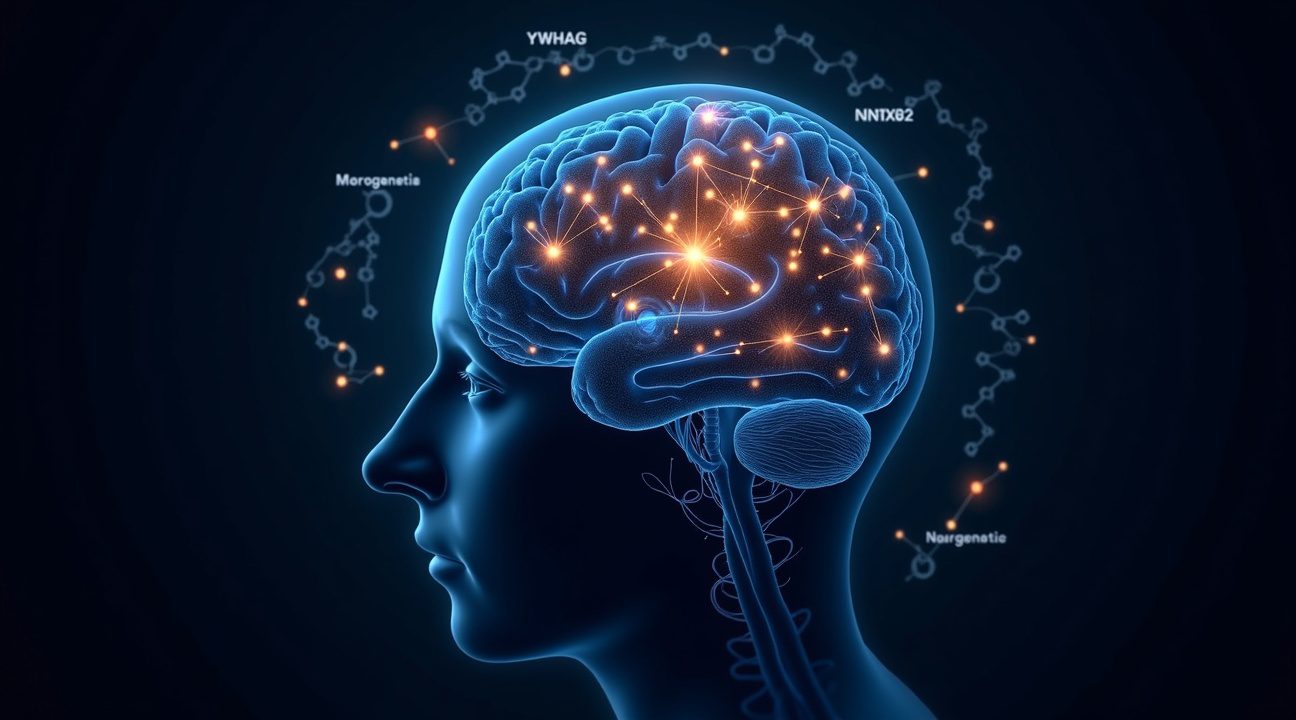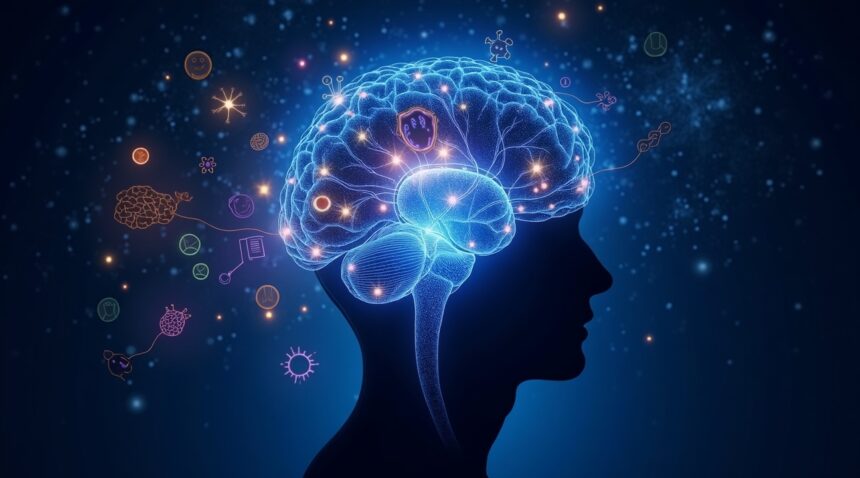Recent groundbreaking research from UC Irvine and the University of British Columbia (UBC) has transformed our understanding of how the brain ages, revealing that neurogenesis—previously believed to halt early in life—continues throughout the human lifespan.
Key Takeaways
- Continued Neurogenesis: The adult brain retains the remarkable ability to generate new neurons well into old age, especially within the hippocampus, a region crucial for memory formation.
- Two Key Types of Memory Cells: Researchers have identified two specialized types of memory cells—item memory cells and ovoid cells—that actively support learning and object recognition across the lifespan.
- New Alzheimer’s Biomarker: The YWHAG:NPTX2 protein ratio has emerged as a promising early biomarker for Alzheimer’s disease, shifting years before clinical symptoms present and potentially explaining resilience in certain individuals.
- Cutting-edge Treatment Approaches: Scientists are developing revolutionary treatments, including the use of engineered microglia as biological delivery mechanisms and combination drug therapies aimed at reversing or halting memory loss.
- Early Detection Advancements: New blood tests capable of identifying Alzheimer’s disease markers years ahead of symptom onset are becoming more accessible, with 91% of Americans reportedly ready to undergo early screening.
This breakthrough not only redefines our biological knowledge of the human brain but also lays the foundation for future intervention. For more information, you can read the full study from UC Irvine and their collaborators at UBC.
Revolutionary Discovery: Your Brain Never Stops Making New Memory Cells
The human brain harbors an extraordinary secret that scientists have only recently uncovered. Research from UC Irvine and UBC reveals that our brains continue producing fresh neurons throughout our entire lives, even as we age. This groundbreaking discovery challenges everything researchers thought they knew about brain function and memory formation.
For decades, scientists believed that neurogenesis—the process of creating new brain cells—stopped early in human development. They assumed our brains reached peak capacity in childhood and then began an inevitable decline. Recent findings paint a dramatically different picture. The adult brain remains a dynamic organ capable of regenerating memory cells well into old age.
Specialized Neurons That Keep Memory Alive
Scientists identified specific types of neurons that play crucial roles in maintaining cognitive function throughout life. These specialized cells include:
- Item memory cells that help recognize and store information about new objects and experiences
- Ovoid cells that contribute to memory formation and retrieval processes
- Hippocampal neurons that support learning and spatial memory
- Newly formed neurons that integrate into existing memory networks
The hippocampus, a seahorse-shaped region deep within the brain, serves as the primary hub for this ongoing neurogenesis. This area processes new experiences and transforms them into lasting memories. Scientists discovered that even elderly brains maintain the ability to generate fresh neurons in this critical region.
I find this research particularly fascinating because it suggests our brains possess built-in mechanisms for self-renewal. The discovery of specialized memory cells demonstrates just how sophisticated our neural networks truly are. Each type of neuron serves specific functions, working together to maintain cognitive performance.
Adult neurogenesis occurs through a complex process where stem cells differentiate into functional neurons. These new cells don’t just sit idle—they actively integrate into existing neural circuits. They form connections with established neurons and begin contributing to memory formation within weeks of their creation.
The implications extend far beyond basic neuroscience. This discovery offers hope for millions facing cognitive decline and Alzheimer’s disease. If scientists can understand how to enhance or protect neurogenesis, they might develop new treatments for memory-related disorders.
Research shows that various factors influence the brain’s ability to create new neurons. Physical exercise, learning new skills, and quality sleep all promote neurogenesis. Environmental enrichment and social interaction also support the formation of fresh brain cells. Understanding these connections helps explain why some people maintain sharp cognitive function well into their golden years.
The brain’s capacity for self-renewal extends beyond simple cell replacement. New neurons bring enhanced plasticity to aging brains. They strengthen existing memory networks and create additional pathways for information storage and retrieval. This redundancy helps protect against the natural cell loss that occurs with aging.
Scientists continue studying the mechanisms that control adult neurogenesis. They’re investigating how different regions of the brain coordinate neuron production and integration. The research reveals that our brains operate more like renewable systems than previously imagined.
This paradigm shift affects how we think about aging and cognitive health. Instead of accepting memory decline as inevitable, we can focus on supporting our brain’s natural regenerative processes. The discovery that proper sleep enhances brain function aligns perfectly with these findings about ongoing neurogenesis.
The research also highlights the brain’s remarkable adaptability. Even when faced with age-related challenges, healthy brains continue producing the cellular machinery needed for learning and memory. This resilience explains why many older adults can still acquire new skills and form lasting memories.
Future studies will explore ways to optimize neurogenesis throughout life. Scientists are investigating pharmaceutical interventions, lifestyle modifications, and therapeutic approaches that could enhance the brain’s natural regenerative capacity. These efforts may lead to breakthrough treatments for neurodegenerative diseases.

Scientists Identify Two Breakthrough Memory Cell Types That Work Throughout Life
Scientists have made remarkable discoveries about two distinct types of memory cells that continue functioning even as people age. These breakthrough findings reveal how the brain maintains its ability to form new memories throughout life, offering fresh insights into memory formation and potential treatments for cognitive decline.
Item Memory Cells: The Brain’s Experience Organizers
Researchers have identified specialized neurons called item memory cells located in the lateral entorhinal cortex. These cells serve as the brain’s filing system, responding to specific sensory cues and their associated outcomes. When someone encounters a reward or punishment, these neurons create detailed mental maps that help organize experiences for future recall.
Item memory cells demonstrate remarkable specificity in their function. They activate in response to particular sensory inputs and form lasting connections with the outcomes of those experiences. This process allows the brain to build comprehensive memory traces that link objects, experiences, and their consequences. The lateral entorhinal cortex acts as a critical hub where these connections form, creating a sophisticated network that supports long-term memory formation.
Scientists have determined that these cells represent one of three foundational aspects of memory formation – the “what” component. This discovery complements existing knowledge about spatial (“where”) and temporal (“when”) memory functions. Together, these three elements create the complete picture of how memories form and persist throughout life.
Ovoid Cells and Object Recognition Memory
The second major discovery involves ovoid cells found in the hippocampus. These specialized neurons activate specifically when individuals encounter new objects, providing a dedicated mechanism for object recognition memory. Research shows that ovoid cells maintain their functionality even as the brain ages, which explains how people retain the ability to recognize and categorize new items throughout their lives.
Evidence from animal models has proven essential to understanding how these neural circuits operate. Scientists observed that disruptions in either item memory cells or ovoid cells directly correlate with memory-related disease progression. This connection provides valuable insights into how memory formation processes may become compromised in conditions like Alzheimer’s disease.
The hippocampus, where ovoid cells reside, has long been recognized as central to memory formation. However, the discovery of these specific cell types reveals a more detailed understanding of how different aspects of memory processing occur. Ovoid cells appear to specialize in novelty detection, creating distinct neural signatures for unfamiliar objects and experiences.
A Collaborative System for Lifelong Memory Formation
Both cell types work together to create comprehensive memory traces:
- Item memory cells provide the contextual framework by linking sensory information with outcomes.
- Ovoid cells ensure that new information gets properly encoded and distinguished from existing memories.
This partnership explains how the brain maintains its capacity for learning and memory formation even in advanced age.
The persistence of these memory cell types throughout life offers encouraging news for aging populations. Unlike some neural functions that decline with age, these specialized neurons continue operating effectively, suggesting that the fundamental machinery for memory formation remains intact. This discovery challenges previous assumptions about age-related memory decline and points toward new therapeutic possibilities.
Enhancing Memory Through Lifestyle and Intervention
Understanding how these cells function also provides insights into why certain types of memory remain strong while others may weaken with age. Object recognition memory, supported by ovoid cells, often stays remarkably stable throughout life. Similarly, the ability to form associations between experiences and outcomes, facilitated by item memory cells, can persist well into advanced age.
Research continues to explore how external factors might support the function of these critical memory cells. Scientists are investigating whether lifestyle factors, cognitive training, or specific interventions might enhance the performance of item memory cells and ovoid cells. The goal is to develop strategies that maintain or even improve memory function by supporting these essential neural circuits.
The discovery of these two distinct memory cell types represents a significant advancement in neuroscience research. By understanding how the brain continues generating new memory cells throughout life, scientists can better address cognitive decline and develop more effective treatments for memory-related conditions. This research also reinforces the importance of proper brain health maintenance to support these vital cellular processes.

Why Some People’s Brains Resist Alzheimer’s While Others Don’t
Scientists have identified a crucial biomarker that explains why some individuals maintain sharp cognitive function well into their golden years while others face devastating memory loss. The YWHAG:NPTX2 protein ratio serves as an early warning system, changing years before Alzheimer’s symptoms become apparent. This ratio reflects the ongoing health of synapses, the critical connections between brain cells that enable memory formation and retention.
The Power of NPTX2 Protein in Brain Protection
NPTX2 protein acts as a guardian of synaptic resilience, directly influencing how well neural connections withstand age-related damage. Research demonstrates that boosting NPTX2 levels in animal models provides significant protection against cognitive decline. This discovery points to promising therapeutic targets for maintaining mental sharpness throughout the aging process.
Brain scans reveal that individuals with higher NPTX2 levels maintain stronger neural circuits, even when carrying genetic risk factors typically associated with Alzheimer’s disease. The protein essentially reinforces the brain’s ability to form new connections and preserve existing ones, creating a buffer against neurodegeneration.
Genetic and Molecular Mechanisms Behind Cognitive Resilience
Some people possess remarkable resistance to Alzheimer’s despite having genetic predispositions that normally increase disease risk. Their brains continue producing new memory cells through sustained neurogenesis, a process once thought to decline dramatically with age. These protective mechanisms include:
- Enhanced DNA repair systems that maintain cellular integrity
- Improved waste clearance processes that remove toxic protein buildups
- Stronger inflammatory responses that protect rather than damage brain tissue
- More efficient energy production in brain cells
- Better stress response systems that prevent cellular damage
Research indicates that cognitive resilience isn’t simply about avoiding risk factors—it’s about actively maintaining protective biological processes. Understanding brain mysteries continues to reveal how complex neural networks adapt and survive.
People with exceptional cognitive resilience often maintain robust NPTX2 levels throughout their lives, suggesting this protein plays a central role in neuroprotection. Their synaptic health remains stable even as chronological age advances, demonstrating that biological aging doesn’t necessarily equal cognitive decline.
The implications extend beyond individual differences in aging. Quality sleep patterns and lifestyle factors can influence these protective mechanisms, offering hope for intervention strategies that could enhance cognitive resilience across populations.
Current research focuses on developing treatments that could boost NPTX2 production or mimic its protective effects. Early intervention based on biomarker testing might allow doctors to strengthen synaptic health before symptoms appear, fundamentally changing how we approach Alzheimer’s prevention.

Game-Changing Treatments Now in Development Based on Memory Cell Research
The discovery that memory cells continue forming throughout life has sparked a revolution in treatment development. Scientists are now crafting innovative therapies that harness this natural process to combat Alzheimer’s disease and cognitive decline. These breakthrough approaches represent a fundamental shift from traditional treatments that merely slow progression to strategies that could potentially restore brain function.
Living Delivery Systems Transform Treatment Precision
Engineered microglia are emerging as one of the most promising therapeutic innovations. These modified immune cells function as sophisticated delivery systems within the brain, releasing therapeutic agents precisely where damage occurs. Unlike conventional drugs that affect the entire brain, engineered microglia can target specific areas of inflammation and memory loss.
Animal studies demonstrate remarkable potential for these living therapeutics. Researchers have successfully programmed microglia to reduce brain inflammation while simultaneously protecting existing memory circuits. The cells act as biological sensors, detecting areas of neuronal stress and responding with targeted interventions. This precision approach addresses one of medicine’s greatest challenges: delivering treatments directly to affected brain regions without causing unwanted side effects elsewhere.
The technology builds on our growing understanding of how memory formation works at the cellular level. By working with the brain’s natural repair mechanisms rather than against them, engineered microglia offer hope for treatments that could halt or even reverse cognitive decline.
Combination Therapies Attack Multiple Disease Pathways
Dual-drug strategies represent another frontier in cognitive protection research. Preclinical trials combining letrozole and irinotecan have shown exceptional promise in addressing Alzheimer’s complex pathology. This combination approach targets multiple disease mechanisms simultaneously, offering more comprehensive protection than single-drug treatments.
The letrozole-irinotecan combination demonstrates several key benefits in laboratory studies:
- Significant reduction in tau protein clumps that characterize Alzheimer’s disease
- Improved learning capabilities in test subjects
- Enhanced memory retention across various cognitive tasks
- Reduced overall brain inflammation markers
- Protection of existing neural connections
Gene therapy approaches are also gaining momentum, particularly treatments designed to boost beneficial proteins like NPTX2. These therapies work by enhancing the brain’s natural ability to form and maintain memory connections. Rather than introducing foreign substances, gene therapies amplify existing protective mechanisms within brain cells.
Cell-based therapies complement these pharmaceutical approaches by introducing healthy, functioning cells directly into damaged brain regions. These treatments leverage the body’s capacity for neural regeneration, supporting the formation of new memory circuits while protecting existing ones. Early research suggests that combining cell-based interventions with targeted drug therapies could create synergistic effects that surpass individual treatment benefits.
The integration of sleep research has also informed treatment development, as scientists recognize that quality sleep plays a crucial role in memory consolidation and brain health. New treatments increasingly incorporate strategies to optimize sleep patterns alongside direct therapeutic interventions.
These emerging therapies represent a paradigm shift in treating cognitive disorders. Instead of accepting decline as inevitable, researchers are developing tools that work with the brain’s inherent plasticity and regenerative capacity. The combination of engineered cells, targeted drug combinations, and gene therapies offers unprecedented hope for maintaining cognitive function throughout aging.
Clinical trials for several of these innovative treatments are expected to begin within the next few years, bringing laboratory breakthroughs closer to real-world applications. The convergence of multiple therapeutic approaches suggests that effective treatments for Alzheimer’s and age-related cognitive decline may finally be within reach.
Blood Tests Could Soon Detect Alzheimer’s Years Before Symptoms Appear
Early detection of Alzheimer’s disease has reached a breakthrough moment with the development of blood tests that can identify disease markers years before any symptoms emerge. These minimally invasive screening tools represent a fundamental shift from traditional diagnostic approaches that often relied on expensive brain scans or invasive procedures after cognitive decline had already begun.
Revolutionary Biomarkers Enable Earlier Screening
Blood-based diagnostics now focus on identifying specific proteins and genetic markers that signal Alzheimer’s development long before memory loss becomes apparent. Plateletcrit, a measure of platelet volume in blood, has emerged as one promising biomarker that researchers can track through simple blood draws. Additionally, scientists are examining APOE4 resilience alleles, genetic variations that may indicate either increased risk or protective factors against the disease.
These blood tests work by detecting tau proteins, amyloid beta accumulations, and other molecular changes that occur in the brain during early Alzheimer’s progression. Unlike previous methods that required lumbar punctures or costly PET scans, these tests require only a standard blood sample that can be processed in most medical laboratories. The convenience factor makes routine screening far more practical for widespread population health initiatives.
Public Readiness Drives Implementation
Consumer acceptance of early Alzheimer’s screening has proven remarkably high, with surveys indicating that 91% of Americans would take a reliable early blood test for the disease. This overwhelming support suggests that people are ready to embrace proactive health management rather than waiting for symptoms to appear. The psychological benefit of knowing one’s risk status early allows individuals to make informed decisions about lifestyle changes, treatment options, and future planning.
Healthcare systems are beginning to incorporate these screening protocols into routine checkups, particularly for patients over 50 or those with family histories of dementia. Early detection enables healthcare providers to implement intervention strategies that may slow disease progression or delay symptom onset. Memory research continues advancing our understanding of how the brain processes and stores information, contributing valuable insights to these diagnostic developments.
The shift toward early screening also opens doors for personalized medicine approaches. When doctors identify Alzheimer’s markers years before symptoms appear, they can tailor treatment plans to individual genetic profiles and risk factors. This precision medicine approach may include:
- Specific medications
- Cognitive training programs
- Dietary modifications
- Exercise regimens designed to support brain health
Blood test accessibility removes many barriers that previously prevented early Alzheimer’s detection. Cost considerations become more manageable since blood draws are significantly less expensive than brain imaging. Geographic limitations disappear as well, since most medical facilities can collect and process blood samples without specialized equipment.
The timeline for widespread implementation appears promising, with several blood tests already approved for clinical use and others advancing through regulatory approval processes. Healthcare providers are training staff on proper collection and interpretation protocols to ensure accurate results. Sleep quality research also supports these efforts by demonstrating how proper rest contributes to brain health and may influence biomarker levels.
Research continues refining these diagnostic tools to improve accuracy and reduce false positive rates. Scientists are working to establish standardized reference ranges for different populations and age groups. This ongoing development ensures that blood-based Alzheimer’s screening will become increasingly reliable and widely adopted.
The combination of high public acceptance, technological advancement, and healthcare system readiness positions blood-based Alzheimer’s screening to become a standard component of preventive care. This proactive approach represents a significant departure from reactive treatment models, offering hope for better outcomes through early intervention and lifestyle modifications that may preserve cognitive function longer.
Hope for 7 Million Americans as Brain Research Transforms Aging Outlook
The staggering reality of Alzheimer’s disease touches millions of families across America today. More than 7 million Americans currently live with this devastating condition, and this number continues to climb as the population ages. Each diagnosis brings uncertainty, fear, and questions about what lies ahead.
Recent groundbreaking discoveries about the brain’s ability to generate new memory cells throughout life have fundamentally shifted the scientific perspective on aging and cognitive health. These findings challenge decades of accepted wisdom that suggested the adult brain couldn’t produce new neurons. Instead, researchers now understand that neurogenesis—the birth of new brain cells—continues well into advanced age, offering unprecedented hope for those facing cognitive decline.
Scientific Discovery Transforms Public Health Outlook
The implications for public health extend far beyond individual families affected by dementia. Understanding that the brain maintains its capacity for renewal and repair throughout life opens entirely new avenues for prevention and treatment strategies. This discovery suggests that cognitive decline isn’t an inevitable consequence of aging but rather a process that might be influenced, delayed, or even prevented.
Several key factors emerge from this research that could dramatically impact how society approaches brain health:
- Lifestyle interventions may prove more powerful than previously thought in supporting ongoing neurogenesis
- Educational and cognitive training programs could help maintain mental sharpness by encouraging new cell growth
- Physical exercise appears to directly stimulate the production of new brain cells, particularly in memory-related regions
- Social engagement and meaningful relationships may play crucial roles in supporting brain cell regeneration
- Proper sleep patterns contribute significantly to the brain’s ability to create and integrate new neurons
The aging population stands to benefit enormously from these insights. Rather than accepting cognitive decline as unavoidable, older adults can now approach brain health with concrete strategies backed by scientific evidence. This knowledge empowers individuals to take active steps in maintaining their mental faculties, potentially extending their years of independent living and meaningful engagement with loved ones.
Healthcare systems across the country are beginning to incorporate these findings into their approaches to cognitive health. Prevention programs that once focused solely on managing existing conditions now emphasize supporting the brain’s natural regenerative processes. This shift represents a fundamental change from reactive treatment to proactive enhancement of brain function.
The research also reveals that memory formation and recall processes remain more dynamic than previously understood. New neurons don’t just replace old ones—they integrate into existing networks, potentially enhancing memory capacity and cognitive flexibility even in advanced age.
Quality of life improvements become achievable through targeted interventions that support neurogenesis. Families watching loved ones struggle with memory issues now have reason for optimism beyond hope alone. The science provides concrete pathways for maintaining cognitive function and possibly slowing the progression of decline.
Medical professionals increasingly recognize that sleep quality affects brain health in ways that directly support new cell growth. This understanding helps explain why some individuals maintain sharp minds well into their nineties while others experience earlier decline.
The economic implications are substantial as well. If interventions based on neurogenesis research can delay the onset of cognitive decline by even a few years, the savings in healthcare costs and the preservation of productive years could be enormous. Families might spend less on long-term care while enjoying more quality time with mentally engaged relatives.
This research transforms the narrative around aging from one of inevitable decline to one of continued potential. The brain’s remarkable ability to regenerate itself throughout life means that advancing age doesn’t automatically signal the end of learning, growing, or creating new memories. Instead, it opens possibilities for individuals to maintain their cognitive edge and continue contributing meaningfully to their communities well into their later years.

Sources:
Stanford Medicine – Alzheimer’s Resilience Signature Predicts Who Will Develop Dementia
University of British Columbia (UBC) – Meet the Newly Discovered Brain Cell That Allows You to Remember Objects
University of California, Irvine (UCI) – Engineered Microglia Show Promise for Treating Alzheimer’s, Other Brain Diseases
Charter Research – Alzheimer’s Research in 2025
UCI Health – Discovery of Item Memory Brain Cells Offers New Alzheimer’s Clues
UC San Francisco (UCSF) – Do These Two Cancer Drugs Have What It Takes to Beat Alzheimer’s
Weill Cornell Medicine – Looking Beyond Beta Amyloid: New Paths in Alzheimer’s Research


